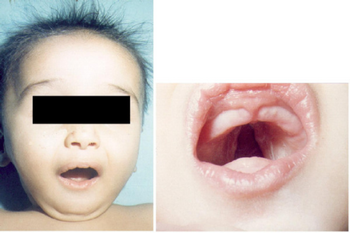Bamforth–Lazarus syndrome
Jump to navigation
Jump to search
Bamforth–Lazarus syndrome is a genetic condition that results in thyroid dysgenesis.[1][2] It is due to recessive mutations in forkhead/winged-helix domain transcription factor (FKLH15 or TTF2).[3]It is associated with FOXE1.[4]
References
- ↑ Bamforth JS, Hughes I, Lazarus J, John R (June 1986). "Congenital anomalies associated with hypothyroidism". Arch. Dis. Child. 61 (6): 608–9. doi:10.1136/adc.61.6.608. PMC 1777822. PMID 3729532.
- ↑ Bamforth JS, Hughes IA, Lazarus JH, Weaver CM, Harper PS (January 1989). "Congenital hypothyroidism, spiky hair, and cleft palate". J. Med. Genet. 26 (1): 49–51. doi:10.1136/jmg.26.1.49. PMC 1015536. PMID 2918525.
- ↑ Kopp P (June 2002). "Perspective: genetic defects in the etiology of congenital hypothyroidism". Endocrinology. 143 (6): 2019–24. doi:10.1210/en.143.6.2019. PMID 12021164.
- ↑ Venza I, Visalli M, Parrillo L, De Felice M, Teti D, Venza M (March 2011). "MSX1 and TGF-beta3 are novel target genes functionally regulated by FOXE1". Hum. Mol. Genet. 20 (5): 1016–25. doi:10.1093/hmg/ddq547. PMID 21177256.
External links
| Classification | |
|---|---|
| External resources |
